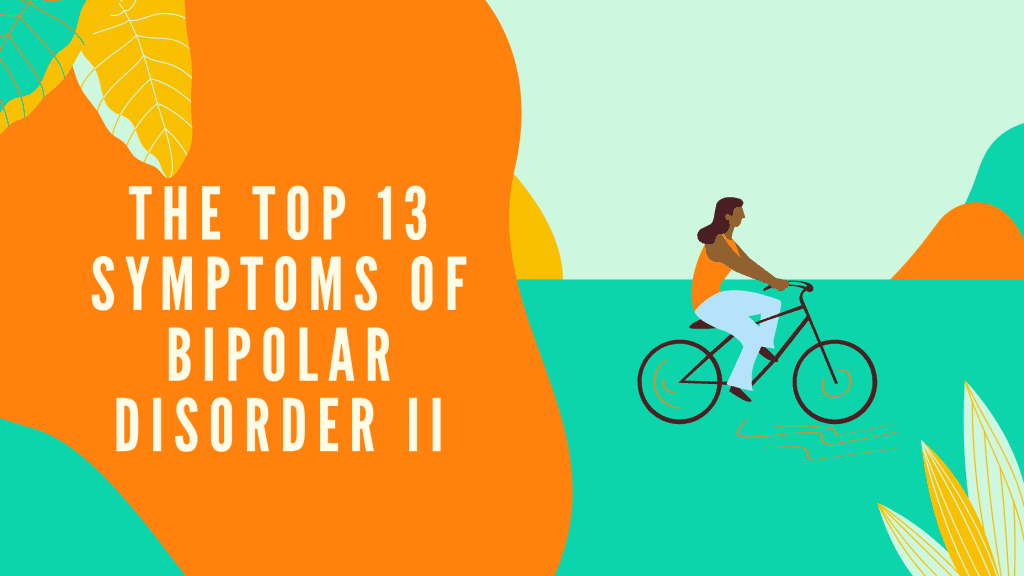The Top 13 Symptoms of Bipolar Disorder II

Bipolar II Symptoms & The Importance of Accurate Diagnosis
Bipolar II disorder is often misunderstood and overshadowed by its more dramatic counterpart, Bipolar I. However, for those living with Bipolar II, the condition is no less impactful. It is characterized by alternating episodes of hypomania and major depression, creating a rollercoaster of emotions that can disrupt daily life. In this post, we’ll break down the top 13 symptoms of Bipolar II disorder in a way that’s easy to understand, while also offering insights into how these symptoms manifest and affect individuals.
For more guidance on bipolar disorder, check out our book and masterclass to reclaim control of your life.
What Makes Bipolar II Unique?
Before diving into the symptoms, it’s important to understand what sets Bipolar II apart. Unlike Bipolar I, which involves full-blown manic episodes, Bipolar II features hypomania—a milder form of mania that doesn’t include psychosis or require hospitalization. However, the depressive episodes in Bipolar II are often more severe and longer-lasting than those in Bipolar I. This combination of subtle highs and crushing lows makes it a uniquely challenging condition to identify and manage.
This is why it is crucial to talk to a doctor who can help guide you to the right diagnosis. Bipolar II is often confused with issues related to thyroid health, gut-health issues, and more.
Hypomanic Symptoms
Hypomania can feel like a burst of energy and creativity for some, but it often leads to impulsive decisions and strained relationships. Here are seven key symptoms to watch for during hypomanic episodes:
- Elevated or Irritable Mood: Individuals may feel unusually cheerful or overly irritable for days at a time. This isn’t your average good mood—it’s excessive and noticeable to others.
- Increased Energy Levels: People with hypomania often feel energized and hyperactive, even with little to no sleep. This surge of energy can lead to over-committing to tasks or projects and eventual burnout.
- Rapid Speech: Talking faster than usual, jumping from one idea to another, or dominating conversations are common signs. Others may find it difficult to keep up with their train of thought.
- Grandiosity: Hypomanic individuals may develop an inflated sense of self-confidence or believe they’re capable of extraordinary feats, leading them to take on unrealistic goals.
- Impulsive Behavior: Risk-taking behaviors such as overspending, gambling, or engaging in unsafe sexual activities are hallmark signs of hypomania. These actions often have long-term consequences that only become apparent later.
- Distractibility: Hypomania brings heightened creativity but also makes it hard to focus on one task for long periods. External stimuli can easily pull attention away from important responsibilities. This symptom can lead to being misdiagnosed with ADHD alone.
- Decreased Need for Sleep: Despite sleeping only a few hours—or not at all—individuals in a hypomanic state may still feel rested and ready to tackle the day with vigor. An effective over the counter supplement to reclaim sleep is Magnesium.
Depressive Symptoms
For many with Bipolar II disorder, depressive episodes are the most debilitating aspect of the condition. These episodes can last weeks or even months and significantly impair daily functioning like going to school, holding a job, or keeping domestic responsibilities. Here are six common depressive symptoms:
- Persistent Sadness or Hopelessness: A pervasive feeling of sadness or emptiness dominates depressive episodes, making it hard to find joy in anything—even activities that once brought happiness.
- Loss of Interest in Activities: Known as anhedonia, this symptom involves losing interest in hobbies, relationships, or work that were previously fulfilling. It’s one of the most telling signs of depression in Bipolar II disorder.
- Fatigue and Low Energy: Depression saps energy levels, leaving individuals feeling physically and emotionally drained—even after sufficient rest. Simple tasks like getting out of bed can feel overwhelming.
- Sleep Disturbances: Sleep patterns often change during depressive episodes—some people experience insomnia while others sleep excessively but still feel exhausted upon waking up.
- Feelings of Guilt or Worthlessness: Individuals may dwell on past mistakes or feel like a burden to others, leading to intense guilt and diminished self-esteem that can spiral into further depression.
- Suicidal Thoughts: In severe cases, thoughts about death or suicide may emerge during depressive episodes. This symptom requires immediate attention and intervention from mental health professionals. Call the suicide hotline immediately if you are dealing with suicidal ideation.
How These Symptoms Interact
One of the most challenging aspects of Bipolar II disorder is the unpredictable cycling between hypomanic and depressive states—or sometimes experiencing periods where both sets of symptoms overlap (known as mixed features). While hypomania might seem manageable or even enjoyable at first glance, it often precedes a crash into depression that feels all the more devastating by comparison.
Why Early Recognition Matters
Bipolar II disorder is often misdiagnosed as unipolar depression because depressive episodes tend to dominate the condition’s course. Without recognizing the presence of hypomania, individuals may not receive the appropriate treatment—leading to prolonged suffering and ineffective interventions.
Treatment typically includes mood stabilizers such as lithium or lamotrigine, psychotherapy (e.g., cognitive-behavioral therapy), and lifestyle modifications like regular exercise and sleep hygiene. At BP Harmony, we guide you to find natural solutions to alleviate and even possibly reverse your diagnosis.
Living with Bipolar II Disorder: A Message of Hope
While living with Bipolar II disorder can be challenging, it’s important to remember that effective treatments exist—and recovery is possible with the right support system in place. Many people with this condition lead fulfilling lives by learning how to manage their symptoms through therapy, medication, and self-care strategies.
If you or someone you know is experiencing symptoms outlined here, don’t hesitate to seek professional help—it’s never too late to take control of your mental health journey.
By understanding these 13 key symptoms, we can foster greater awareness about Bipolar II disorder—breaking down stigma while empowering individuals to seek help when they need it most.
Citations:
- https://www.baptisthealth.com/care-services/conditions-treatments/bipolar-2-disorder
- https://archives.palarch.nl/index.php/jae
- https://www.webmd.com/bipolar-disorder/bipolar-2-disorder
- https://www.nimh.nih.gov/health/publications/bipolar-disorder
- https://www.psychologytoday.com/us/therapists/imran-hyder-ghani-sugar-land-tx/1303744
- https://www.nhs.uk/mental-health/conditions/bipolar-disorder/
- https://www.medicalnewstoday.com/articles/319280
- https://www.who.int/news-room/fact-sheets/detail/bipolar-disorder


